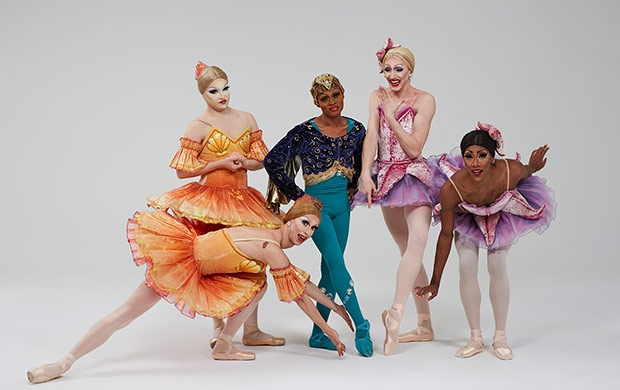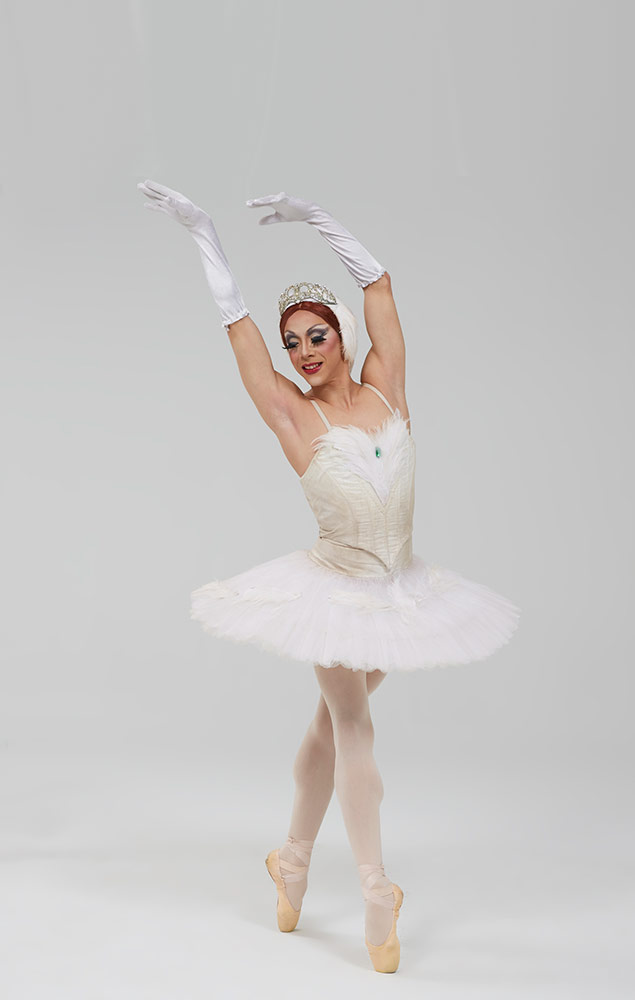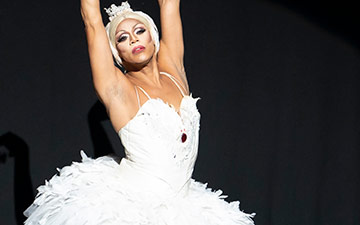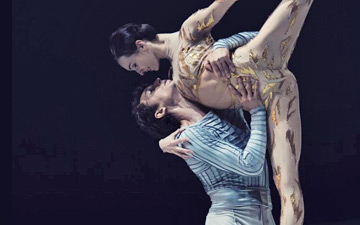
© Zoran Jelenic. (Click image for larger version)
Les Ballets Trockadero de Monte Carlo
Programme A: Le Lac des Cygnes (Swan Lake act II), Harlequinade pas de deux, Trovatiara pas de cinq, Dying Swan, The Little Humpbacked Horse
★★★★★
London, Peacock
12 September 2018
trockadero.org
peacocktheatre.com
www.danceconsortium.com
The all-male Trocks are divinely absurd, as are the 19th century ballets they revere and ridicule. Though they take on female roles, they aren’t trying to emulate women on pointe: they are embodying old-school prima ballerinas who graced ornate ballets with preposterous plots.
As the years (and wars and revolutions) went by, those plots were simplified and the original choreography was altered or lost. But relics lingered in performers’ memories, photographs and films. Excerpts surfaced for ballet students’ graduation shows or competitions – regarded as too quaint, perhaps, for adult professionals. The Trocks have seized upon these antique gems with glee, adding them to a bejewelled collection of familiar classics.
Back on tour in Britain, their opening programme includes an abbreviated Act II of Swan Lake (1895), an underwater scene from The Little Humpbacked Horse (1864), a pas de deux from Les Millions d’Harlequin (1901) and a tribute to 19th century opera ballets, Trovatiara pas de cinq (2002). And, of course, an immortal Dying Swan. The moulting bird’s teetering bourrées excepted, the choreography is a joy, danced in the appropriate grand manner with added pratfalls.
The Trocks’ version of Swan Lake (or Lac, as it used to be known) restores some Soviet era removals. Benno, the hero’s best friend and supporter, is back, as are mime sequences, mostly mystifying the participants: Siegfried doesn’t speak swan. The corps of eight swan-maidens, elbow-length gloves covering hairy forearms, pretend to cower as victims of fiendish Von Rothbart (Joshua Thake, as Jacque d’Aniels). They are more like vengeful Wilis, intimidating bewildered Benno (Roberto Vega as Mikhail Mypansarov).

© Zoran Jelenic. (Click image for larger version)
Their Queen (Carlos Hopuy, as Alla Snizova) is a dignified figure, investing her trust in Siegfried (Duane Gosa, as Vladimir Legupski). He is a reliable partner, though he hands over catching duties to Benno, as did ageing Pavel Gerdt in the original Lac des Cygnes. Siegfried is a poseur, while Odette is completely committed to her tragic role. Hopuy dances her solo variations impeccably, his ballerina line fine apart from his masculine shoulders.
Now that the Trocks’ technique is so strong in choreography created for light-weight women, they need to demonstrate that they are pretty beefy men, not trans-gender dancers, or the essence of their loving parody of ballet loses its point. They are witty comedians, bringing out the craziness of classical ballet so that we laugh with them, while admiring their muscular skill on pointe.
Take the Harlequinade pas de deux, so winsome that it’s usually danced as a competition number by very young dancers. Long Zhou and Takaomi Yoshino, as Nina Enimenimynimova and Boris Dumbkopf, rise to the challenges of its choreography, allegedly ‘after’ Marius Petipa, while prancing and pouting gaily. English National Ballet should never have included the pas de deux in its Emerging Dancer showcase. Like the Dying Swan solo, the pas de deux is best left to the Trocks.
Peter Anastos, founder of Les Ballets Trockadero de Monte Carlo in 1974, reunited with the company in 2002 after a distinguished career as a director, choreographer, teacher and writer, to create the Trovatiara pas de cinq for five dancers en travesti. A delectable comic ballet to music from Verdi’s operas, it sends up villainous ‘pirate’ ballets with abducted heroines: Le Corsaire, Daphnis and Chloe, Sylvia. Exotic captive girls are commanded to dance their best steps by a cruel Emir. They are guarded or assisted by warriors with rubber scimitars.

© Zoran Jelenic. (Click image for larger version)
Two diminutive zouaves barely reach the waist of tall Joshua Thake, formerly Von Rothbart, now prima ballerina Eugenia Repelskii. She supports herself during a pas de trois by putting her hand on their heads. There are virtuoso variations, unaccountable folk-dance rivalries and syncopated duels. A programme note reassures us that the girls will be set free and sent forth to open coin-operated laundries all over Europe.
It’s hard to believe that The Little Humpbacked Horse, based on a children’s fairy-tale, is still being performed in various versions (the latest by Alexei Ratmansky in 2009), to music either by Pugni and Drigo, or Rodion Schedrin. The Trocks’ account of the underwater scene, mounted by Elena Kunikova, goes back to the 1901 staging by Alexander Gorsky to Pugni’s score. The submarine denizens, colourfully clad by Kenneth Busbin, do not include the magic horse.
The corps, in mottled grey-blue lycra, are described as medusas, or jellyfish. They are enthusiastic admirers of the soloists: pink corals, red and gold fish, turquoise Queen of the Underwater and her consort, the Genie of the realm. Elsewhere, the Genie is called Ocean and the dainty maidens dancing a pas de trois with him are Pearls. (Their duet is often excerpted for student and gala performances.) He, Haojun Xie as Nicholas Kachafallenjar, takes his role seriously, dancing as well as he can. Veteran Robert Carter as Olga Supphozova dominates the scene as its powerful Queen, rightfully taking centre stage for the elaborate tableau at the end. In between have come all the multiple pirouettes, fouettés, gargouillades and hops on pointe required in a show-off divertissement.
The Trocks prove that ballet serves as pure entertainment, ably danced by guys of different sizes, shapes, ages and skin colours. They channel the glamorous personalities of yesteryear, rejoicing in their assumed Russian noms de danse – names that are passed on to new recruits (Helen Highwater is back again) like those of traditional kabuki performers. Long may they continue to flourish.

















You must be logged in to post a comment.